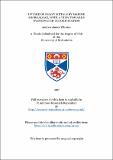Files in this item
Uptake of heavy metals by marine microalgae, with a view towards wastewater detoxification
Item metadata
| dc.contributor.advisor | Smith, Valerie | |
| dc.contributor.advisor | McAuley, Paul | |
| dc.contributor.author | Whiston, Andrew James | |
| dc.coverage.spatial | 213 p. | en_US |
| dc.date.accessioned | 2018-06-18T15:03:23Z | |
| dc.date.available | 2018-06-18T15:03:23Z | |
| dc.date.issued | 1997 | |
| dc.identifier.uri | https://hdl.handle.net/10023/14212 | |
| dc.description.abstract | Treatment of waste water by freshwater microalgae is rapidly becoming a popular sewage treatment practice throughout the world, but only a few studies have been made into the use of marine strains or of their potential for heavy metal removal. This study examines the heavy metal tolerance of a range of marine microalgal species and examines some of the biological processes involved in metal uptake. Initially over 350 marine microalgal species/isolates were screened for (a) growth in the presence of heavy metals (10 ppm), (b) growth in the presence of wastewater (1:1 sewage : seawater), and (c) heavy metal uptake. Of the microalgae examined, only one isolate, Tetraselmis sp. (TSAW92) was found to satisfy all of the screening conditions. Metal uptake was found to be a biphasic process, with an initial rapid saturable metabolism-independent stage followed by a slower nonsaturable metabolism-dependent stage. Using a novel filtration technique metal uptake was measured at ten second intervals. The results show that most of the metal uptake occurs within one minute after exposure. The second stage of metal uptake was found to be associated with the extracellular release of up to three copper binding proteins of ca. 28, 30, 55 kDa. Protein release was specifically induced by the presence of heavy metals and was not due to metal mediated increases in cell membrane permeability. Two practical applications of Tetraselmis sp. (TSAW92) metal uptake were investigated. First dried biomass was evaluated in a simple packed column. Second, live cells were grown on a wastewater treatment raceway (2m), upstream of a Dunaliella salina stocked nutrient removal raceway. Dried Tetraselmis sp. (TSAW92) was capable of removing copper from a 1:1 seawater : sewage solution to a final loading of 30% at an efficiency of approaching 100%. Over four weeks live TSAW92 removed 100% of the applied copper to a final loading of 37%, and, after the second stage, the raceway was found to remove 95% of the applied nitrogen and 87% of the applied phosphorus. This thesis shows that marine microalgae are capable of removing heavy metals from wastewater in vitro, on raceways, and as dried biomass. Live marine microalgae on raceways were further found to remove inorganic nutrients (nitrogen and phosphorous). In addition work is presented which suggests that copper uptake by the marine chlorophyte Tetraselmis sp. (TSAW92) is mediated through extracellular copper binding proteins. | en_US |
| dc.language.iso | en | en_US |
| dc.publisher | University of St Andrews | |
| dc.subject.lcc | QK565.W5 | en |
| dc.subject.lcsh | Algae culture | en |
| dc.title | Uptake of heavy metals by marine microalgae, with a view towards wastewater detoxification | en_US |
| dc.type | Thesis | en_US |
| dc.contributor.sponsor | Biotechnology and Biological Sciences Research Council (BBSRC) | en_US |
| dc.type.qualificationlevel | Doctoral | en_US |
| dc.type.qualificationname | PhD Doctor of Philosophy | en_US |
| dc.publisher.institution | The University of St Andrews | en_US |
This item appears in the following Collection(s)
Items in the St Andrews Research Repository are protected by copyright, with all rights reserved, unless otherwise indicated.

